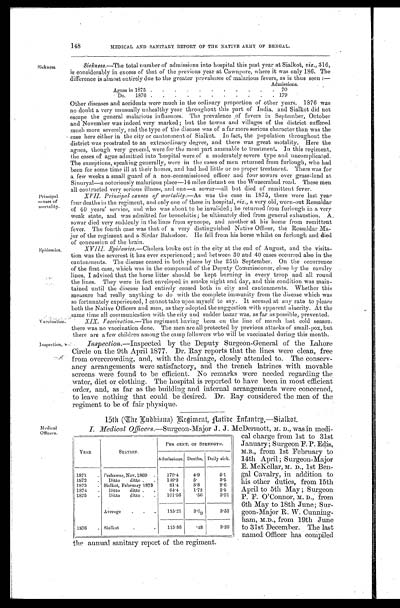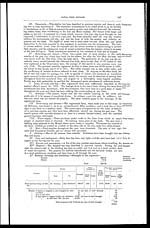Medicine - Institutions > Army health reports and medical documents > Medical and sanitary report of the native army of Bengal > Medical and sanitary report of the native army of Bengal for the year 1876
(178) Page 148
Download files
Individual page:
Thumbnail gallery: Grid view | List view

148
MEDICAL AND SANITARY REPORT OF THE NATIVE ARMY OF BENGAL.
Sickness.
Sickness. —The total number of admissions into hospital this past year at Sialkot, viz., 316,
is considerably in excess of that of the previous year at Cawnpore, where it was only 186. The
difference is almost entirely due to the greater prevalence of malarious fevers, as is thus seen:—
| Admissions. | |
| Agues in 1875 | 70 |
| Do. 1876 | 179 |
Other diseases and accidents were much in the ordinary proportion of other years. 1876 was
no doubt a very unusually unhealthy year throughout this part of India, and Sialkot did not
escape the general malarious influences. The prevalence of fevers in September, October
and November was indeed very marked; but the towns and villages of the district suffered
much more severely, and the type of the disease was of a far more serious character than was the
case here either in the city or cantonment of Sialkot. In fact, the population throughout the
district was prostrated to an extraordinary degree, and there was great motality. Here the
agues, though very general, were for the most part amenable to treatment. In this regiment,
the cases of ague admitted into hospital were of a moderately severe type and uncomplicated.
The exceptions, speaking generally, were in the cases of men returned from furlough, who had
been for some time ill at their homes, and had had little or no proper treatment. There was for
a few weeks a small guard of a non-commissioned officer and four sowars over grass-land at
Sinuryal—a notoriously malarious place—14 miles distant on the Wuzeerabad road. These men
all contracted very serious illness, and one—a sowar—all but died of remittent fever.
Principal
causes of
mortality.
XVII. Principal causes of mortality. —As was the case in 1875, there were last year
four deaths in the regiment, and only one of these in hospital, viz., a very old, worn-out Ressaldar
of 40 years' service, and who was about to be invalided; he returned from furlough in a very
weak state, and was admitted for bronchitis; he ultimately died from general exhaustion. A
sowar died very suddenly in the lines from syncope, and another at his home from remittent
fever. The fourth case was that of a very distinguished Native Officer, the Ressaldar Ma-
jor of the regiment and a Sirdar Bahadoor. He fell from his horse whilst on furlough and died
of concussion of the brain.
Epidemics.
XVIII. Epidemics. —Cholera broke out in the city at the end of August, and the visita-
tion was the severest it has ever experienced; and between 30 and 40 cases occurred also in the
cantonments. The disease ceased in both places by the 25th September. On the occurrence
of the first case, which was in the compound of the Deputy Commissioner, close by the cavalry
lines, I advised that the horse litter should be kept burning in every troop and all round
the lines. They were in fact enveloped in smoke night and day, and this condition was main-
tained until the disease had entirely ceased both in city and cantonments. Whether this
measure had really anything to do with the complete immunity from the disease which was
so fortunately experienced, I cannot take upon myself to say. it seemed at any rate to please
both the Native Officers and men, as they adopted the suggestion with apparent alacrity. At the
same time all communication with the city and sadder bazar was, as far as possible, prevented.
Vaccination.
XIX. Vaccination. —The regiment having been on the line of march last cold season.
there was no vaccination done. The men are all protected by previous attacks of small-pox, but
there are a few children among the camp followers who will be vaccinated during this month.
Inspection.
Inspection.—Inspected by the Deputy Surgeon-General of the Lahore
Circle on the 9th April 1877. Dr. Ray reports that the lines were clean, free
from overcrowding, and, with the drainage, closely attended to. The conserv-
arrangements were satisfactory, and the trench latrines with movable
screens were found to be efficient. No remarks were needed regarding the
water, diet or clothing. The hospital is reported to have been in most efficient
order, and, as far as the building and internal arrangements were concerned,
to leave nothing that could be desired. Dr. Ray considered the men of the
regiment to be of fair physique.
15th (The Ludhiana) Regiment, Native Infantry,—Sialkot.
Medical
Officers.
| YEAR | STATION. | PER CENT. OF STRENGTH. | ||
| Admissions. | Deaths. | Daily sick. | ||
| 1871 | Peshawar, Nov.1869 | 179.4 | 4.9 | 5.1 |
| 1872 | Ditto ditto | 149.3 | 5. | 3.5 |
| 1873 | Sialkot, February 1873 | 81.4 | 3.3 | 2.6 |
| 1874 | Ditto ditto | 64.4 | 1.72 | 2.5 |
| 1875 | Ditto ditto | 101.56 | .56 | 3.91 |
| Average | 115.21 | 3.09 | 3.52 | |
| 1876 | Sialkot | 115.86 | .48 | 3.20 |
I. Medical Officers. —Surgeon-Major J. J. McDermott, M. D., was in medi-
cal charge from 1st to 31st
January; Surgeon F. P. Edis,
M.B., from 1st February to
14th April; Surgeon-Major
E. McKellar, M. D., 1st Ben-
gal Cavalry, in addition to
his other duties, from 15th
April to 5th May; Surgeon
P. F. O'Connor, M. D., from.
6th May to 18th June; Sur-
geon-Major R. W. Cunning-
ham, M.D., from 19th June
to 31st December. The last
named Officer has compiled
the annual sanitary report of the regiment.
Set display mode to: Large image | Zoom image | Transcription
Images and transcriptions on this page, including medium image downloads, may be used under the Creative Commons Attribution 4.0 International Licence unless otherwise stated. ![]()
| Permanent URL | https://digital.nls.uk/74998509 |
|---|




